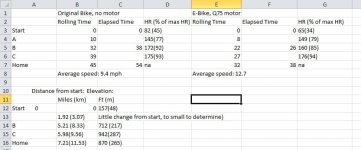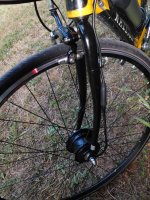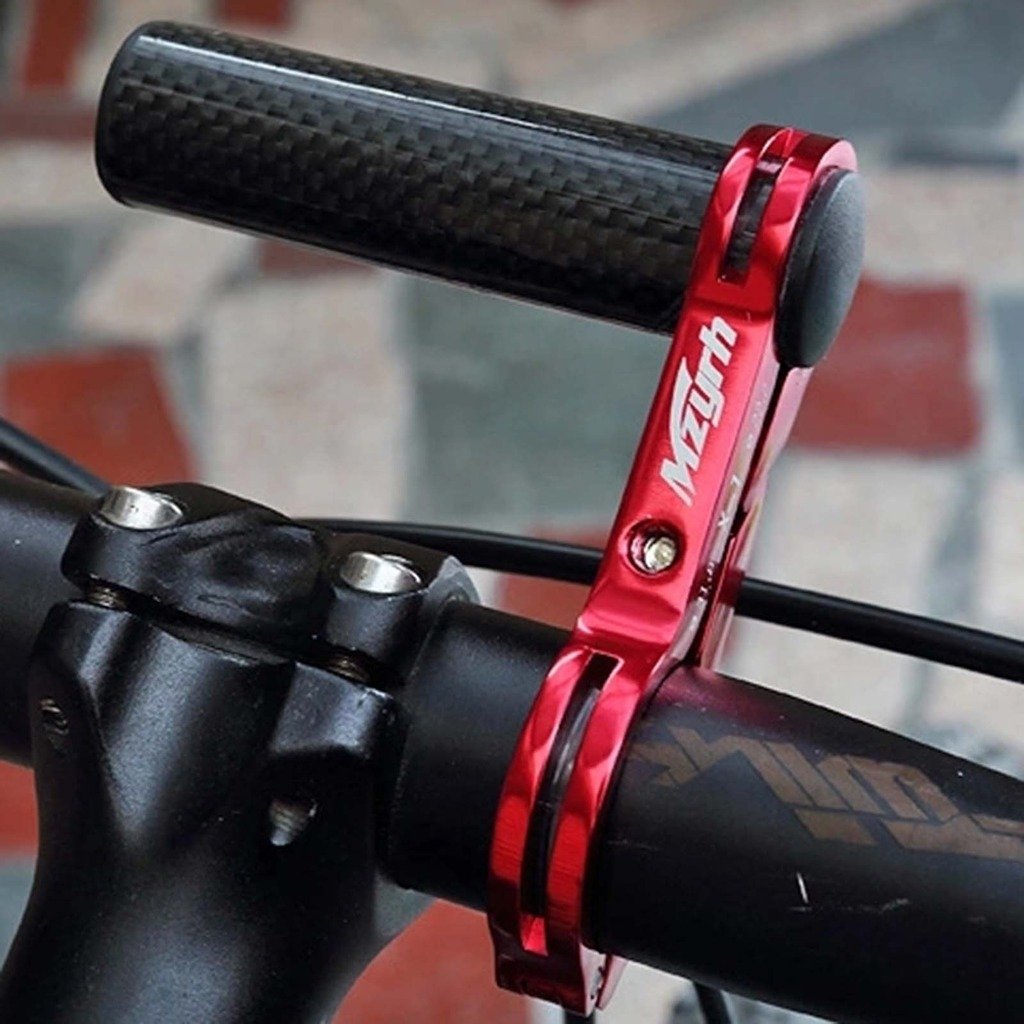abecrizer
100 mW
Hello, I posted on ES for the first time months ago to get advice about the best bike for my needs.
see: https://endless-sphere.com/forums/viewtopic.php?f=28&t=76292
I completed the project based on the advice I got and I want to share my results.
I will make several posts blow: 1st one with the my evaluation and results of the conversion
2nd with more detail about the parts, the conversion process and problems
3rd with a description of the context.
4th with questions for improvement (if this is better in it's own topic pls let me know).
My goals with these posts:
1) Is to provide my experience regarding what I have so others can use this info to figure
things out for themselves.
2) To show how it fit on my bike and how I solved a few installation problems.
I did a Q75 front wheel with a sine wave controller kit from BMS battery (details in 2nd post).
Subjective:
Overall I am happy with it, there are pros and cons, but the design objectives really boil down to make my bike so
I will ride it a lot instead of a litte, and this is achieved:
Pros:
-Cuts down on ride time
-I feel like I have more "reserve": I would get too out of beathe and would need to stop to rest at times without
the motor. I would feel that if a truck was about to run me over I would have no additional energy to try to get out
of the way. Now I feel like I still have a little more to give if the need arises. (Obviously I am not in very good shape, just admitting that)
-Riding seems like more of something I can do every day instead of a herculean effort that I must work up to psychologically.
-Does not take over, it assists and this feels substantial, like a heavy hand is pushing you, but it is not tempting to just let the motor do all the work
Cons:
- I think the bike doesn't look as cool with a soup can for a hub and a clunky steel fork (Vainity I know, just being honest)
- Bike is Heavier
- A little less self-satisfaction: When I did do my ride before with no motor and I crested the last hill, I felt lucky to be alive, and simultaneously like I had triumphed over some great hardship. I still feel good, but not so intensely
Objective:
I did a ride pre-conversion and recorded the data from it, and then did the same ride with the conversion so you can see the difference objectively. For some reason you have to click on this file, I can't get it to be seen inline.
*I tried to put this table in text form, but I could not get the formating right for the columns to line up,
so here is a screen shot of my spread sheet.
Explaination of the process is below:
I did the same ride both times, I stopped at the same points and measured the the above data:
The rolling time is a time my speed-o-meter counts only while the bike is moving. If I get stopped
a a traffic light, or stop because I am having chest pain, or if I stop for a beer and cigarette it will not count.
As you can see from the difference between to rolling time and the elapsed time on first ride, I stopped a lot for breaks.
The elapsed time is the number of minutes since starting the ride regardless of how many stops.
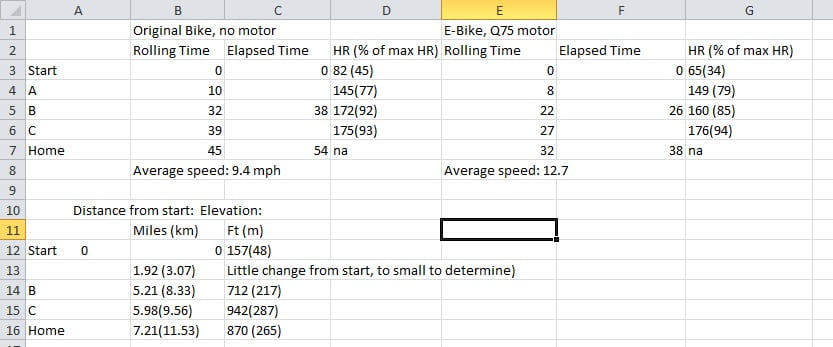
HR = Heart rate, measured from a cheapo HR moniter I have
I stopped for rest breaks several times without the motor, and never did with the motor.
I wanted to post numbers because while every response I recieved to my original post was helpful,
I could tell that there was an internal tension in ES users about their own values vs responding based on what I said I
wanted. Some people strongly recommended the q75, others said it is not worth the weight and effort to install.
I am sure both are true for those users, but I hope that these numbers will help others compare my experience to their
own expectations/desires to see if this is a good set up for themselves.
Pre=conversion bike:
View attachment 2
E-bike post conversion:
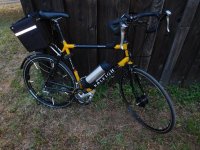
see: https://endless-sphere.com/forums/viewtopic.php?f=28&t=76292
I completed the project based on the advice I got and I want to share my results.
I will make several posts blow: 1st one with the my evaluation and results of the conversion
2nd with more detail about the parts, the conversion process and problems
3rd with a description of the context.
4th with questions for improvement (if this is better in it's own topic pls let me know).
My goals with these posts:
1) Is to provide my experience regarding what I have so others can use this info to figure
things out for themselves.
2) To show how it fit on my bike and how I solved a few installation problems.
I did a Q75 front wheel with a sine wave controller kit from BMS battery (details in 2nd post).
Subjective:
Overall I am happy with it, there are pros and cons, but the design objectives really boil down to make my bike so
I will ride it a lot instead of a litte, and this is achieved:
Pros:
-Cuts down on ride time
-I feel like I have more "reserve": I would get too out of beathe and would need to stop to rest at times without
the motor. I would feel that if a truck was about to run me over I would have no additional energy to try to get out
of the way. Now I feel like I still have a little more to give if the need arises. (Obviously I am not in very good shape, just admitting that)
-Riding seems like more of something I can do every day instead of a herculean effort that I must work up to psychologically.
-Does not take over, it assists and this feels substantial, like a heavy hand is pushing you, but it is not tempting to just let the motor do all the work
Cons:
- I think the bike doesn't look as cool with a soup can for a hub and a clunky steel fork (Vainity I know, just being honest)
- Bike is Heavier
- A little less self-satisfaction: When I did do my ride before with no motor and I crested the last hill, I felt lucky to be alive, and simultaneously like I had triumphed over some great hardship. I still feel good, but not so intensely
Objective:
I did a ride pre-conversion and recorded the data from it, and then did the same ride with the conversion so you can see the difference objectively. For some reason you have to click on this file, I can't get it to be seen inline.
*I tried to put this table in text form, but I could not get the formating right for the columns to line up,
so here is a screen shot of my spread sheet.
Explaination of the process is below:
I did the same ride both times, I stopped at the same points and measured the the above data:
The rolling time is a time my speed-o-meter counts only while the bike is moving. If I get stopped
a a traffic light, or stop because I am having chest pain, or if I stop for a beer and cigarette it will not count.
As you can see from the difference between to rolling time and the elapsed time on first ride, I stopped a lot for breaks.
The elapsed time is the number of minutes since starting the ride regardless of how many stops.
HR = Heart rate, measured from a cheapo HR moniter I have
I stopped for rest breaks several times without the motor, and never did with the motor.
I wanted to post numbers because while every response I recieved to my original post was helpful,
I could tell that there was an internal tension in ES users about their own values vs responding based on what I said I
wanted. Some people strongly recommended the q75, others said it is not worth the weight and effort to install.
I am sure both are true for those users, but I hope that these numbers will help others compare my experience to their
own expectations/desires to see if this is a good set up for themselves.
Pre=conversion bike:
View attachment 2
E-bike post conversion:



